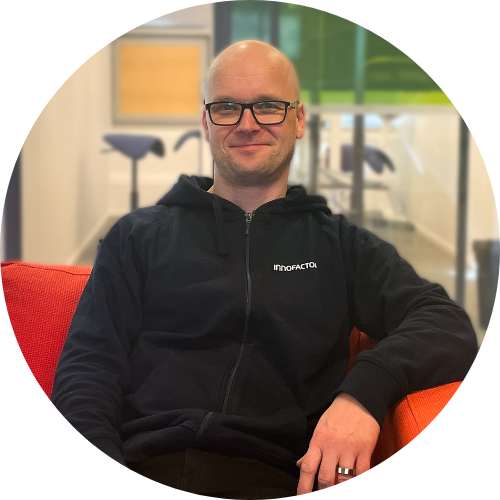Team support is invaluable – What is Innofactor’s team model?
At Innofactor, our agile team model is at the core of how we work and deliver value to our customers. Each team brings together the right mix of skills, experiences, and responsibilities to ensure smooth collaboration and effective delivery.
Innofactor’s teams work with agile methods. Projects make progress one period, or sprint, at a time. When projects are divided into parts, problems encountered can be reacted to faster and it is easier to perceive large entities. The team model also supports open, continuous dialogue both within the team and with the customer and other stakeholders.
But our way of working goes beyond roles and responsibilities. AI is a measurable part of our daily operations—not just an experiment. We use AI to increase efficiency, productivity, and quality across all levels of the organization. Intelligent agents and AI-powered tools support our people in everyday tasks, enabling them to focus on meaningful work, decision-making, and innovation.
This means our agile teams are not only supported by each other but also by the latest technology. AI enhances collaboration, accelerates delivery, and helps us maintain a consistent focus on customer outcomes.
By combining skilled professionals with AI-driven ways of working, Innofactor’s team model ensures continuous improvement and evolving value for our customers. It’s how we stay ahead—and help our customers do the same.
We asked People Manager Marko Lappalainen from the Business Solutions unit to tell us what it is like to work in a team at Innofactor.
What is your role as People Manager? 
People Managers focus on the human side of things, such as team members' well-being at work, coping and competence development. People Managers discuss these themes with each team member in monthly one-on-one meetings. Moreover, the People Manager is always there to support team members whenever needed.
People Managers interact closely, particularly with People Managers in the same unit. Naturally, co-operation with HR is also included in the job description.
What kind of roles does an agile team at Innofactor include?
The Quarterback (or Scrum Master), Business Coach, and People Manager make up the team's management team. The teams consist of specialists, each with their own technical and not-so-technical strengths. For example, not all team members need to know how to write code. The quarterback is a team member who, among other things, facilitates team activities, directs the team’s joint meetings, and ensures that the team follows common rules. In addition, the quarterback represents the team in monthly coaching sessions, where the news of various teams are shared and reviewed. The quarterback is on the same level with the other team members, which means that the quarterback does not have the right to direct, but matters are decided on together.
The People Manager and Business Coach provide help and support from outside when needed, but do not interfere with the team's work.
How does the team model work in practice?
The structure of the teams varies slightly, depending on the customer. The teams’ activities are based on Innofactor’s Team Playbook, the rules of which are modified to suit the needs of the customer and the team.
The teams decide among themselves for example common rules, the schedules for regular meetings and how far the visibility of the backlog, i.e. the project's prioritized to-do list, will go. The teams also define the conditions for when an individual assignment can be marked as completed. This is referred to as the definition of ready. The rules decided in mutual understanding help ensure that the team's work is of the highest possible quality, and consistent. The company's common minimum of teamwork, on the other hand, ensures that even though each team has their own agreed ways of working, they work consistently enough with other teams.

What are the biggest advantages of the team model?
The team model makes the work transparent, so that any problems there may become visible quickly. Communication also runs smoothly, as messages flow efficiently from many different fronts without unnecessary intermediaries. The low hierarchy of our organization also helps in this.
Our developers often emphasize the importance of sparring partners. It is impossible for one person to know everything about everything, but everyone has their personal strengths. That is why it is good that the team is always there to provide support for solving problems and sounding off ideas. The team model encourages co-operation, so that no-one is left alone to tackle challenges. In addition to support inside the team, our Coaches are there to help with for example scrum work, business and possibly even issues related to personal career development.
If the team needs new members, team members are involved in both the recruitment process and planning of induction from the very beginning. When the team itself plans the induction of a new colleague, joining the team goes smoothly. For example, our DigiStars can quickly get to grips with practical work, because their induction has been thoroughly thought out.
What makes a good team?
All our teams are good, of course! Each team is unique, and there are different levels of maturity. However, they all share a passion to develop further and be good at what they do. The cornerstone of all our teams is to generate value to customers. Our teams are proud of their handiwork.
At the individual level, it is important that all team members are team players who like to work openly with others. As the teams have decision-making power, they are also responsible for customers and the progress of projects. A good team member stays on top of what the team is doing and works proactively to achieve common goals, supporting other team members whenever necessary.



